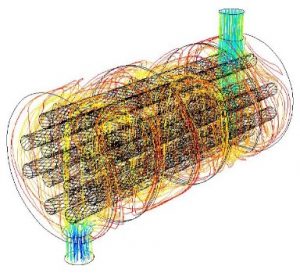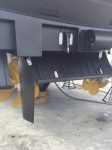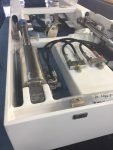We were recently contracted to inspect a leaking heat exchanger on a 130 foot Westport yacht docked at a local marina. The heat exchanger was part of the hydraulic power unit (HPU) for the ship’s bow thruster system. The HPU consists mainly of a motor, a reservoir tank and a hydraulic pump. These units can generate a tremendous amount of power to drive most any kind of hydraulic ram or motor. They can also generate high temperatures. Most heat exchangers used in the marine industry are water cooled and use a water control valve to regulate the flow of water though the exchanger to keep the hydraulic fluid temperature between 64 and 68 degrees C (147 and 155 degrees F). It is important to make sure the adjustments for the water control valve are set properly to avoid rapid overheating.
 This particular model was a shell and tube design. As its name implies, this type of heat exchanger consists of a shell (a large pressure vessel) with a bundle of tubes inside it. One fluid runs through the tubes, in this case hydraulic oil, and another fluid, water, flows over the tubes (through the shell) to transfer heat between the two fluids. The set of tubes is called a tube bundle and may be composed of several types of tubes.
This particular model was a shell and tube design. As its name implies, this type of heat exchanger consists of a shell (a large pressure vessel) with a bundle of tubes inside it. One fluid runs through the tubes, in this case hydraulic oil, and another fluid, water, flows over the tubes (through the shell) to transfer heat between the two fluids. The set of tubes is called a tube bundle and may be composed of several types of tubes.
Upon inspection, we found that the fittings in the heat exchanger were not properly seated and the sealant used was not sufficient for the job. In order to remedy the problem, we needed to remove the heat exchanger from the HPU and send it out for servicing. In order to do this, we had to disconnect the hard pipe Stauff clamps above the heat exchanger in order to spread the pipes apart to remove the heat exchanger from the bilge. We also disconnected and installed caps and plugs in the hoses connected to the heat exchanger. We resealed the adapters and fitting upon re-installation, connected the hydraulic hoses, installed Stauff clamp supports and tested the unit for leaks.
The heat exchanger is back in operation and helping to ensure that the hydraulic bow thrusters are doing their job helping to maneuver this yacht in tight places.








 From time to time, we see some pretty old yachts come into Lauderdale Marine Center as was the case with a 30+ year old Feadship. This old gal was in need of some work to bring her back to her glory days. We were hired to give her hydraulic royal boarding ladder a “face lift.” A hydraulic royal boarding ladder is side mounted typically at mid-ship that retracts using hydraulic folding mechanisms when not in use, leaving your deck free of obstacles.
From time to time, we see some pretty old yachts come into Lauderdale Marine Center as was the case with a 30+ year old Feadship. This old gal was in need of some work to bring her back to her glory days. We were hired to give her hydraulic royal boarding ladder a “face lift.” A hydraulic royal boarding ladder is side mounted typically at mid-ship that retracts using hydraulic folding mechanisms when not in use, leaving your deck free of obstacles.